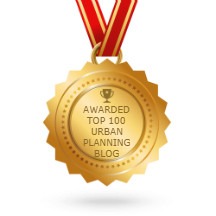Great article on urban design qualities of Kimmel Center in Philadelphia | extendable to civic assets more generally
Proposal for a new Downtown baseball stadium in Kansas City that is tightly integrated into the urban fabric.
My writings on stadiums and arenas have a framework of elements to consider when dealing with a project. It was developed out of the sense that activists oppose such projects, especially public funding, but most of the time they happen regardless, so why not expend our energies on mitigating the problems and yielding the most benefits.
The current stadium complex in Kansas City is surrounded by parking lots, disconnecting it from the city.It hasn't focused so much on interior design as much as broader place characteristics and exterior features, but the comments include a number of articles such as on Milwaukee's Fiserv Arena ("Fiserv Forum's architecture wonderful inside, flawed outside," "The Killers, Violent Femmes rock first Fiserv Forum show, cover 'Laverne & Shirley' song," Milwaukee Journal-Sentinel) with more discussion of the interior architecture, which needs to be included in an update to the framework.
The writings on "transformational projects action planning" discuss both interior and exterior elements. From "A wrinkle in thinking about the Transformational Projects Action Planning approach: Great public buildings aren't just about design, but what they do" (2022):
TPAPs should be implemented at multiple scales:
(1) neighborhood/district/city/county wide as part of a master plan;
(2) within functional elements of a master plan such as transportation, housing, or economic development; and
(3) within a specific project (e.g., how do we make this particular library or transit station or park or neighborhood "great"?); in terms of both
(4) architecture and design; and
(5) program/plan for what the functions within the building accomplish.
Lately, I have been mulling the issue of civic buildings as elements of the creation of neighborhood centers and community centers because of some examples in Salt Lake City and County where the final results are paltry compared to the investment, because a good framework wasn't employed (along with a failure to have a focused plan for the creation of neighborhood centers).
That's why a Philadelphia Inquirer article, "A new cafe at Kimmel is the first step to a better arts center," by Peter Dobrin, the paper's classical music critic is so great.Writing about the Kimmel Center for Performing Arts, which styles itself as an arts campus, the review addresses the power or failure of civic assets to push urban design, placemaking, and revitalization forward as part of the program for the building and site.
Note that the Inquirer is one of the only newspapers in North America that has an urban design writer, Inga Saffron, who is fabulous. Like the Milwaukee Journal-Sentinel's music critic's review of the Arena, Dobrin is particularly insightful. From the article:
The Kimmel Center was trumpeted as Philadelphia’s fifth public square — an 18-hour-per-day, seven-day-a-week arts center where you could show up anytime and find a concert or see a film.
But since it opened in 2001, the Kimmel has sent mixed signals about just how welcoming it really wants to be. Some of this has to do with the architecture — fortresslike from the outside, visually chilly on the inside — but also with the way the Kimmel has policed its spaces, which has sometimes been heavy-handed. On balance, though, this ostensibly public space has never lived up to its promise.
With the recent opening of a cafe in its lobby, Philadelphia’s major arts center is taking another run at inviting the city in.
Yes, I know: In one sense, a few dozen seats and a place to have a macchiato and a country-ham-on-baguette is a modest gesture. But quietly and convincingly, the cafe is already easing one of the arts center’s long-standing deficits. It has made the institution less opaque — metaphorically and physically.
One of the missed opportunities of the original design was failing to recognize the arts center’s most prominent spot, the corner of the structure at Broad and Spruce Streets, as an invitation for transparency. One part of the structure, the enormous pile of masonry at Broad and Spruce, was extended west with a ticketing booth that blocked the view into the plaza. At its front door, the Kimmel had little to signal what goes on inside.
... It’s no accident that arts centers everywhere are becoming more sensitive to atmosphere and user experience. Competition for leisure time is stiff, and getting people to leave their houses, a challenge. The New York Philharmonic has renovated and renamed its home in Lincoln Center, and now the lobby of David Geffen Hall features a 50-foot-long digital screen showing video art during the day and streamed performances of Philharmonic concerts live.
The New York auditorium’s acoustics also got a makeover. The sound was crisper and more present than before in two concerts I heard there in January, and aficionados seem generally impressed.
But then there are those patrons who want to experience music more passively, sitting in the lobby sipping and chatting or scrolling social media as Beethoven streams digitally in the background.
... It’s worth noting that New York has a great deal more public space than Philadelphia — in Lincoln Center plaza, for starters. The Kimmel, with its huge glass dome, functions as a kind of roomy indoor-outdoor gathering space that’s rare here, heightening the importance of making it succeed.
... The symbolic value of the cafe as a space of access to all is important, especially now. The arts are still perceived by some as elitist, and arts attendance took a hit during the pandemic [.]
... The Kimmel has pursued a series of renovations to both its public and private spaces on a rolling basis since opening, both as part of routine maintenance and in response to financial pressures and other factors.
... The tale of the rooftop garden is a good metaphor for the push and pull of operating an arts center. It is a public space, but the institution is also expected to produce enough revenue to offset rental costs for its resident companies (a subject for another day).
The open-air garden atop the Perelman Theater once offered anyone who wanted it a great city view, an escape from the busy city. But the Kimmel, strapped for income, took down the trees and renovated the rooftop perch years ago so it could reap revenue from weddings and other events. Gone was one of the city’s truly fun and surprising public spaces.
The Kimmel needs to evolve further to become the social hub the arts community urgently needs to reintroduce pandemic-weary patrons to the value of live, in-person performances. The New York Philharmonic renovation introduced fun to the place through the architecture, fabrics, and amenities.
Some lessons.
- the building should be permeable (I am a big fan not just of large windows, but garage doors tht open up
- the space should be active, open and "fun"
- there should be connection between the interior and exterior of the building(s)
- there should be connection between the exterior and the area beyond the site
- arts buildings should promote art, not look like just another office building
- outside public spaces should be open and active, not grim and closed off.
Labels: capital improvements planning, civic assets, comprehensive planning/Master Planning, design method, public realm framework, Transformational Projects Action Planning, urban design/placemaking






1 Comments:
https://www.inquirer.com/arts/kimmel-center-cafe-curtain-call-design-20250220.html
Why the Kimmel Center’s new cafe may be a step backward
The arrangement creates a tale of two arts centers — one the café, private and inward looking; and the other the plaza, often quiet, cold, and barren.
Though Curtain Call occupies a small portion of the Kimmel’s Commonwealth Plaza, it has an outsize effect on the entire dome-capped experience. It is the first thing you see when you walk in the main entrance on Broad Street, and announces the mood of the place.
One of the biggest design flaws of the Kimmel Center has always been the tall brick piles that make it difficult to “read” the fun going on inside. The Garces-era cafe mitigated this clunkiness by replacing the long ticketing booth, making the building more airy and permeable. Now, sadly, between the hedges walling off the cafe from the plaza and the newly opaque Spruce Street window, some of that permeability has been reversed.
The arrangement creates a tale of two arts centers — one, the café, private and inward looking; and the other, the plaza, often quiet, cold, and barren.
The arts center’s new food and beverage provider, Rhubarb Hospitality Collection by Oak View Group — which also serves Royal Albert Hall in London and Hudson Yards in New York, among other sites — might consider clearing the window and removing the fake shrubs. But ultimately, the success of the plaza depends on a real, long-discussed renovation for which funding must be secured. At the very least, what’s needed in Commonwealth Plaza are more places to linger, better lighting and acoustic control, and adequate heating in winter.
... But the feeling of the plaza around concert time has always been much more bubbly than at nonperformance times. Over the years, the Kimmel Center has shrunk some of the more public aspects of its operation. The rooftop space above the Perelman Theater is still called the Hamilton Garden, yet its trees were taken down long ago and the public access function replaced by a glass-enclosed rental space. The balcony over Broad Street, with its magnificent view of Broad Street and City Hall, is no longer a restaurant, and is only occasionally open.
La Noche, the monthly Latin dance party, has stopped, and the splashy, ambitious Philadelphia International Festival of the Arts is a distant memory. The orchestra this season is offering free lobby performances as part of its three “Orchestra After 5″ concerts, but the arts center’s website currently lists no forthcoming free events. A spokesperson says the group is fundraising for programming and is talking to “partners about the best way to utilize the space going forward.”
... The Kimmel knows how to do this. It knows how to cultivate a public space in smart ways. Now it needs to sustain free programming with a permanent endowment so it can do it more dependably.
When the Kimmel opened in 2001, there was a feeling among many that it was wedging itself onto an arts scene that didn’t necessarily need it. A lot has happened in two dozen years, and even more in the past month. Now it seems nothing less than indispensable.
The cafe is in the same spot as the old one and retains some of the main design elements — the sea of hydrangea-like light fixtures above, most obviously. Inexplicably, though, a tall row of fake shrubs and a metal-curtain wall now separate the cafe from the plaza, keeping the liveliness of the cafe from being shared with the rest of the ground floor. The once-transparent Spruce Street windows have been made opaque up to a certain height with a dot-matrix appliqué that hinders the view inside from the sidewalk.
Post a Comment
<< Home